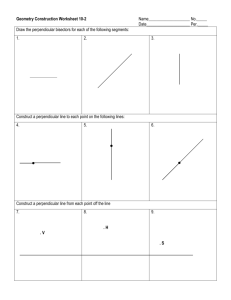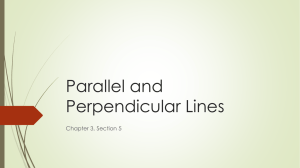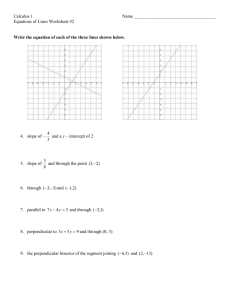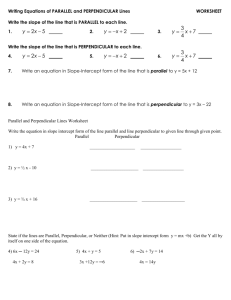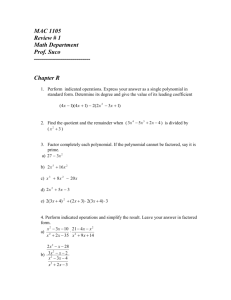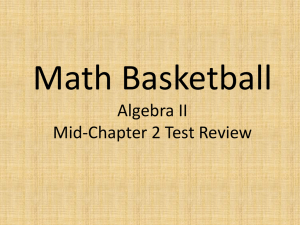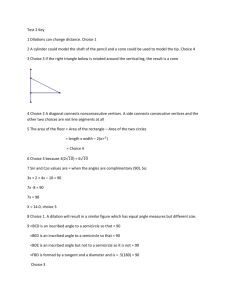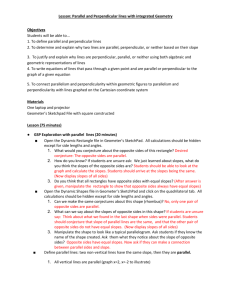Activity 3.3.1 Parallel and Perpendicular Lines
advertisement
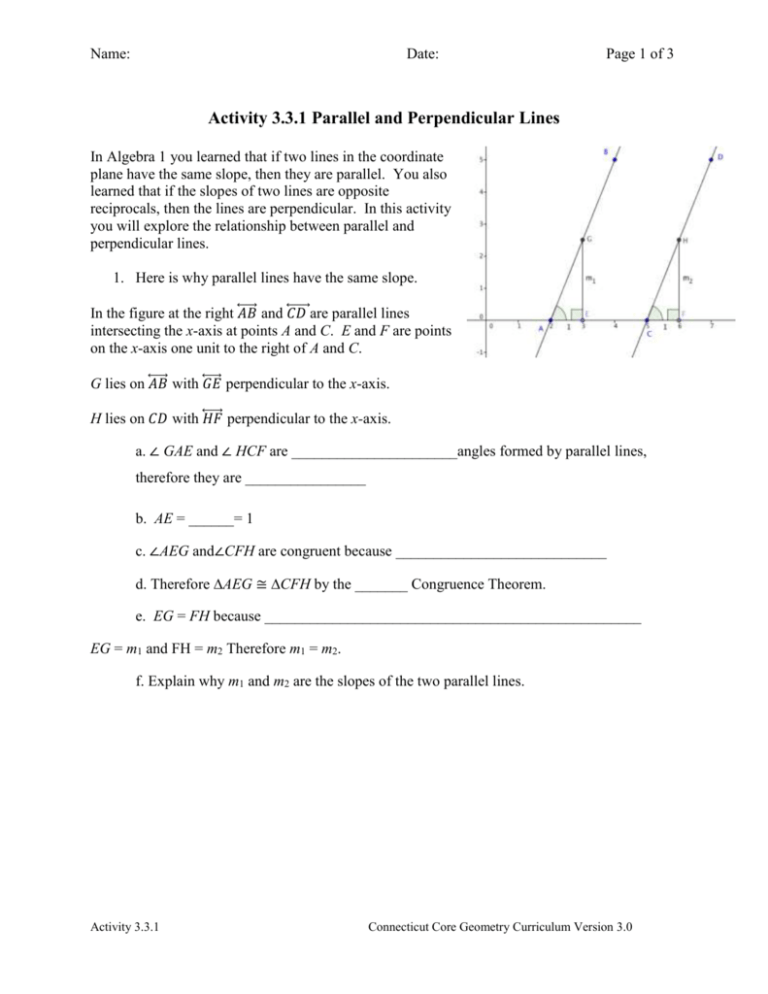
Name: Date: Page 1 of 3 Activity 3.3.1 Parallel and Perpendicular Lines In Algebra 1 you learned that if two lines in the coordinate plane have the same slope, then they are parallel. You also learned that if the slopes of two lines are opposite reciprocals, then the lines are perpendicular. In this activity you will explore the relationship between parallel and perpendicular lines. 1. Here is why parallel lines have the same slope. In the figure at the right ⃡𝐴𝐵 and ⃡𝐶𝐷 are parallel lines intersecting the x-axis at points A and C. E and F are points on the x-axis one unit to the right of A and C. G lies on ⃡𝐴𝐵 with ⃡𝐺𝐸 perpendicular to the x-axis. H lies on 𝐶𝐷 with ⃡𝐻𝐹 perpendicular to the x-axis. a. ∠ GAE and ∠ HCF are ______________________angles formed by parallel lines, therefore they are ________________ b. AE = ______= 1 c. ∠AEG and∠CFH are congruent because ____________________________ d. Therefore ∆AEG ≅ ∆CFH by the _______ Congruence Theorem. e. EG = FH because __________________________________________________ EG = m1 and FH = m2 Therefore m1 = m2. f. Explain why m1 and m2 are the slopes of the two parallel lines. Activity 3.3.1 Connecticut Core Geometry Curriculum Version 3.0 Name: Date: Page 2 of 3 2. Here is why if the slopes of two lines are opposite reciprocals, the lines are perpendicular. (Recall that the product of opposite reciprocals is –1.) We will demonstrate with a specific example. In the figure at the right the coordinates of points A, B, C, D, and E are given. 𝑟𝑖𝑠𝑒 ⃡ . m1 = a. Let m1 be the slope of 𝐴𝐵 = ______________ 𝑟𝑢𝑛 𝑟𝑖𝑠𝑒 b. Let m2 be the slope of ⃡𝐴𝐶. m2 = 𝑟𝑢𝑛 = ______________ (watch out for signs!) c. Show that m1 m2 = –1. (So the slopes are opposite reciprocals.) ⃡ and 𝐴𝐶 ⃡ are perpendicular. Now we need to show that 𝐴𝐵 d. First show that ∆ADB ≅ ∆CEA e. Because corresponding parts of congruent triangles are congruent we know that m∠1 = ________ and m∠2 = __________ f. By the triangle sum theorem we know that m∠1 + m∠2 +m∠ADB = _____ g. By the linear pair postulate we know that m∠1 + m∠BAC + m∠4 = ____ h. Put (e), (f) and (g) together to show that m∠ADB = m∠BAC. i. Explain why the result in (h) means that ⃡𝐴𝐵 ⊥ ⃡𝐴𝐶. Activity 3.3.1 Connecticut Core Geometry Curriculum Version 3.0 Name: Date: Page 3 of 3 3. Horizontal and Vertical Lines Sometimes the slope of a line is not defined. In the figure at the right, a. Which line is horizontal?______ b. Which line is vertical?_______ c. Which line has zero slope?_______ d. For which line is the slope undefined?______ ⃡ ⊥ 𝐴𝐶 ⃡ ?_______ Explain your reasoning. e. Is 𝐴𝐵 4. Perpendicular and Parallel lines. In the figure at the right ⃡𝐶𝐴 ⊥ ⃡𝐴𝐵 and ⃡𝐷𝐵 ⊥ ⃡𝐴𝐵 . 3 The slope of ⃡𝐴𝐵 = − 7. a. Find the slope of ⃡𝐶𝐴 b. Find the slope of ⃡𝐷𝐵 c. Explain why we know that ⃡𝐶𝐴 must be parallel to ⃡𝐷𝐵 . 5. In the figure at the right, a. Which lines, if any, are perpendicular? b. Which lines, if any, are parallel? c. Explain your reasoning. Activity 3.3.1 Connecticut Core Geometry Curriculum Version 3.0
